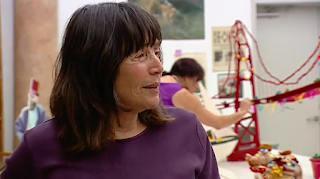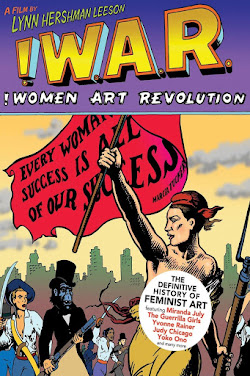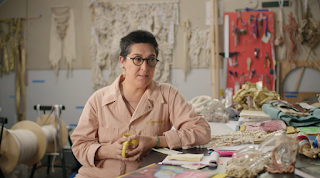Art21: "Humor" (S2, E4)
This episode of Art21 focuses on the idea of "humor," showcasing the artists Eleanor Antin, Raymond Pettibon, Elizabeth Murray, and Walton Ford.

Eleanor Antin Talking about her love for Greek Sculpture. 2003. "Humor," Art21
Eleanor Antin is an American performance artist, filmmaker, and installation artist. She utilizes history (whether it be Grecian, Roman, or her own Jewish heritage) in order understand the present. She even admits to having a great fascination with Grecian life and mythology, wishing she actually lived in Ancient Greece, when she was a little girl. She is facinated for the idea of the narrative, as she believed that "Narrative was so much of a human need as breathing. We are constantly explaining ourselves and communicating in terms of putting material together in some way that has aspects of story." She invents her own history, but also sees herself as the one to know about everything that has happened. In other words, she believes that she was almost "always there" to witness every event that has transpired in some form or another. What I found fascinating is that she didn't believe she had her own "self," which was why she went into acting at first, so she could "borrow from other people." She also utilized this to understand her stance on various social and political issues. She felt that her most glorious female self was in the form of a ballerina. As such, in Love's Shadow she portrays a ballerina that is coveted by a young lover. When he realizes that he can't have her, he shoots her, and falls and grieves over her dead body. In her words, it was about the "unattainability of beauty and love," which could be explained by the actions of the male character but also how she may not see herself as being truly "beautiful." Despite this somber idea, she does tend to see the funny sides of things, because she sees it as the "laughter and tears" coming together. This is evident through her 100 Boots On the Job, and 100 Boots Out of a Job two of many postcards of 100 boots being placed in random places, which makes the work look humorous to the viewer, despite the contrasting title of the later seem depressing.
Love's Shadow (1987) Film.
Raymond Pettibon talking about his work. 2003. "Humor," Art21
Raymond Pettibon is an American artist born in Arizona. He is well known for his ink drawings that combine both image and text. As such, he creates his drawings in terms of a narrative, not in the same sense as a cartoon, as his generally have a punch line, a resolution and a laugh at the end. He admits that "the way I think, the way I talk, and the way I write is not very direct always, it can lead anywhere. I want it to be as fluent as possible, I mean that is a major part of my work." He doesn't outright consider himself a political artist, but doesn't shy away from it. He otherwise believes art can be a wish fulfillment or open our eyes into an alternate universe. I found it difficult to find a work of his that seemed to convey this idea of humor, as most of the work I found I didn't understand the narrative behind it. However, this work from 2011, No title (from life to....), seemed humorous enough to understand. The text reads (from Top to Bottom):
"From Life to Draw, this reservoir to draw upon. To be wiped off the face of the Earth - not without a picture first."
The text makes this work seem profound, as it seems to convey a sense of almost existentialism, however, it depicts these two surfers that are about to be "eaten" by a giant wave, to which the text follows with "not without a picture first." I immediately connected this to how we are constantly posting and taking pictures of everything around us onto social media, as a means to gain popularity. To which, even if someone was in danger, someone could still feel intrigued to get their phone out and document it, because "its a good shot." As such, it makes this idea seem a bit incentive, but I think it could connect to our overreliance to document everything for likes.

No title (from life to....) (2011) Acrylic, Ink and Pastel on paper. 59.5 x 80.2 inches.

Elizabeth Murray talking about her shapes. 2003. "Humor," Art21
Elizabeth Murray is an American painter from Chicago. Her works involve cutting out shapes and combining them together, to which the shapes look cartoony and "wacky." She tries to "make it work," and paints them until "the right thing happens." She ultimately wants them to have conflict and tension, but also "live" together harmoniously. She knows when things work when they make her laugh, since she especially likes to have fun with them. To her, "it's part of what gets me through." In a way, her paintings are a means for her to express her inner feelings, but also conceptualize it where they all somehow "work together." She tends to depict familiar, domestic objects, like cups, drawers, and utensils, thus her work conveys an abstract dream-like atmosphere through a domestic point of view. For instance, Empire conveys a sense of power through the stacking of various pots on a table. The title itself conveys this power, while the heightened stack, taking over the majority of the composition, expresses this idea.

Empire (2001) Watercolor on paper. 18 × 7.5 × 1.75 inches. The Pace Gallery, New York

Walton Ford talking about his work. 2003. "Humor," Art21
Lastly, Walton Ford is an American artist based in New York. He is known for his paintings and prints of animals, inspired from historical events and political commentary. He is interested in conveying both "attraction" and "repulsion" to his viewer, and sometimes dives into conveying some Dark Humor in his work. In his words, "I like the over, broad emotion, melodrama, very 19th century modes of communicating. I'm not a minimalist, I'm a maximalist.. the more you throw at it, the better." One of his works that conveys his interest best is Falling Bough from 2002. This work depicts a plethora of passenger pigeons on a log suspended in the air. At first glance, it looks incredible to see the pigeons emitting from this suspended log, but upon further inspection, the pigeons are seen murdering and fighting each other and stealing eggs. For context, passenger pigeons are an extinct species of pigeon, to which Walton Ford states "there was a whole economy built on destroying these birds and within fifty years they were all gone." His aim was to convey this, in terms of the idea of destroying a part of nature and the brutality that comes with it.

Falling Bough (2002) Watercolor, gouache, ink and pencil on paper. 60.75 × 119.5 inches. Private collection, Tennessee.




Yes, it's hardly material for a laugh. You're right that it's humor as a strategy to open the viewer to serious ideas.
ReplyDelete